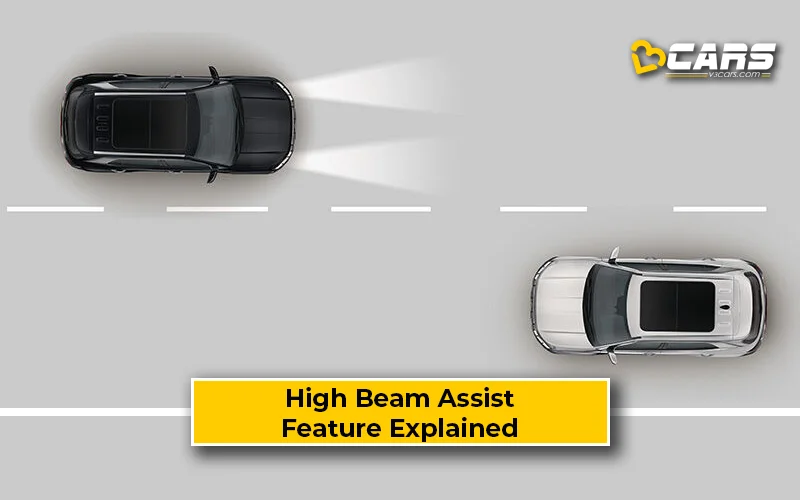High Beam Assist – Feature Explained
Driving at night, especially on unlit roads, requires maximum visibility, often requiring the use of high beams. However, manually switching between high and low beams when encountering other vehicles can be tiring and, if done incorrectly, it can temporarily blind oncoming drivers. This is where high beam assist comes in – a car safety feature designed to automate this process, thus enhancing safety during night journeys.

What Is High Beam Assist?
High Beam Assist is an advanced driver assistance system (ADAS) that automatically controls your vehicle’s high beam headlights. It’s built to provide optimal illumination of the road ahead without dazzling other road users. This technology makes night driving more comfortable and safer by taking away the need for the driver to manually switch the lights.
How Does High Beam Assist Work?
The operation of high beam assist relies on sensors and processers:
- Camera/sensor system: The core of the system is usually a camera or sensor mounted on the windshield, usually next to the inside rearview mirror (IRVM). This sensor continuously monitors the road ahead for light sources.
- Light source detection: The system detects various light sources, including the headlights of oncoming vehicles, the taillights of vehicles ahead, and sometimes even bright street lighting in urban areas.
- Automatic switching: When no other light sources are detected and the road ahead is dark, the system automatically switches on the high beams to provide maximum visibility. As soon as an oncoming vehicle’s headlights or a vehicle’s taillights ahead of you (or bright streetlights) are detected, the system dips the lights to low beam to prevent blinding other drivers. Once the other vehicle has passed or the lighting conditions on the road worsen, the system automatically switches the high beams back on.
- Speed threshold: High Beam Assist typically operates above a certain speed (20-30kmph) to ensure it’s primarily used on highways or open roads.
This continuous, automatic adjustment allows for consistent illumination while ensuring courtesy and safety for everyone on the road.
What Are The Pros And Cons Of High Beam Assist?
Here are the pros, or advantages, of high beam assist:
- Improved night visibility: By automatically maximising light output when safe to do so, it significantly enhances the driver’s view of the road, potential hazards, and road signs.
- Reduced driver fatigue: Automating the high beam operation lessens the driver’s workload, allowing them to focus more on driving and less on switching lights, particularly on long night drives.
- Enhanced safety for others: Prevents accidental blinding of oncoming or preceding drivers, contributing to overall road safety and reducing the risk of head-on collisions.
- Optimised illumination: Ensures you’re always using the best possible light setting for current conditions without manual intervention.
Here are the cons, or disadvantages, of high beam assist:
- Occasional misdetection: The system might sometimes struggle to detect certain light sources (bicycles with dim lights, unlit vehicles, or vehicles partially obscured by bends), leading to delayed dipping or accidental high beam use.
- Lag in response: While generally quick, there might be a slight delay in the system’s reaction time compared to a human driver in very specific, sudden situations.
- Driver over-reliance: Drivers might become too dependent on the system and forget to manually intervene if the system doesn’t perform as expected.
- Limited in urban areas: Often less effective or even inactive in well-lit city environments due to constant ambient light.
Can High Beam Assist Be Installed From The Aftermarket?
No, installing high beam assist from the aftermarket is generally not feasible or advisable with the same level of factory integration and reliability.
A factory-fitted high beam assist system relies on complex integration with the vehicle’s electrical system, headlight controls, and a dedicated camera or sensor that is calibrated to the vehicle’s specific lighting setup. Aftermarket solutions would be difficult to integrate seamlessly and may not offer consistent or reliable performance compared to OEM (Original Equipment Manufacturer) systems. It’s a feature best left to be factory-fitted.
Affordable Cars In India That Offer High Beam Assist?
High beam assist is primarily found as part of broader ADAS packages. As ADAS technology becomes more common, high beam assist is trickling down to more affordable segments, usually in the higher variants.
You can typically find this feature in:
- Honda Amaze
- Kia Sonet
- Hyundai Venue
- Mahindra XUV 3XO
- Hyundai Creta
- Kia Seltos
- Mahindra XUV700
- Tata Harrier and Safari
- Mahindra Scorpio-N
- MG Hector and Hector Plus
While it’s not yet a standard feature in entry-level or base variants, its availability is increasing in the B2- and C-segments as part of ADAS packages.
Also Read: Hill Start Assist Or Hill Hold Control - Feature Explained
Helpful Tools:
- Fuel Cost Calculator for Cars – Know your monthly fuel expense based on usage and mileage
- Car On-Road Price Calculator – Convert ex-showroom to on-road price for any city
Sell Used Car Online – Enter your car and contact details to get an instant price estimate and book a free inspection with our partner network


0 Comments